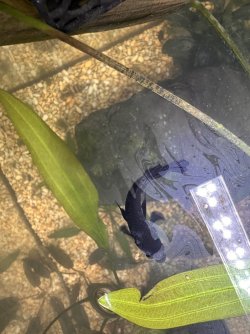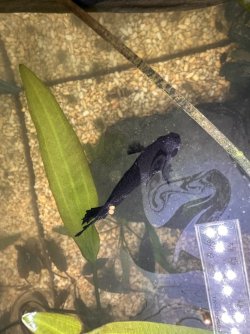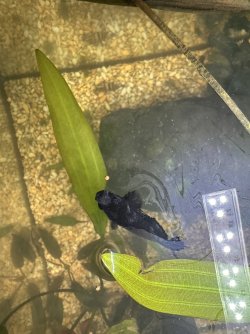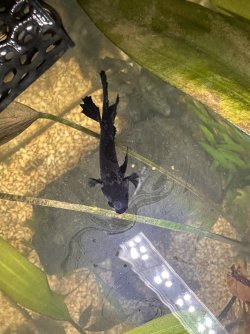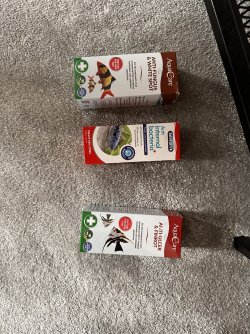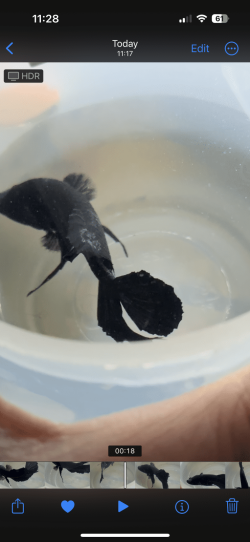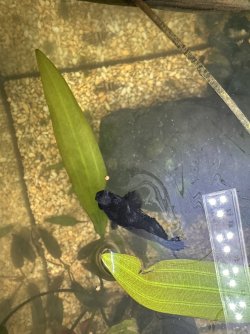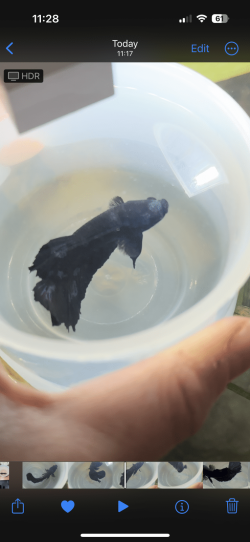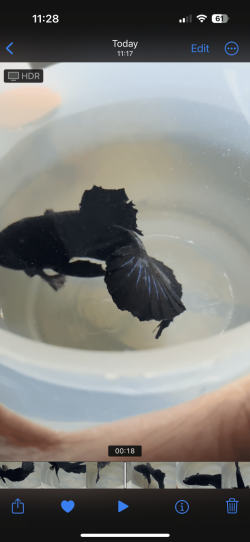Hi I have treated for bacteria and fungus with interpret anti internal bacteria and more recently (finished yesterday) an anti fungus and white spot treatment but both show no signs of helping. He has been like the above getting slowly worse for months now (approx nov?). His fins are getting more ragged but appetite and behaviour are good. Parameter are good tank has been established for >2.5years. 0ppm ammonia/nitrite and nitrates around 10ppm as planted. I am in the uk so some medicines I can’t get! Thanks for help in advance! Suzi
You are using an out of date browser. It may not display this or other websites correctly.
You should upgrade or use an alternative browser.
You should upgrade or use an alternative browser.
Please Help! Columnaris?
- Thread starter Sallen
- Start date
🐠 May TOTM Voting is Live! 🐠
🏆 Click here to Vote! 🏆
Stop adding things unless you know what the problem is.
We need pictures of the fish from the side.
What are the symptoms?
How long has this been going on?
If you are concerned about the creamy white patches on the fish, that is excess mucous produced by the fish in response to something in the water irritating it. It can be poor water quality (ammonia, nitrite, nitrate), plant fertiliser, medications, or chemicals getting into the water from outside the aquarium or from the water source.
Normally you do big (75%) water changes and gravel clean the substrate every day for a week or two in an attempt to dilute whatever is irritating the fish. If that doesn't help then add some carbon to the filter to help remove chemicals and heavy metals from the water. If it's still there after a few water changes and carbon it could be an external protozoan infection like Costia, Chilodonella or Trichodina. these can be treated with salt.
We need pictures of the fish from the side.
What are the symptoms?
How long has this been going on?
If you are concerned about the creamy white patches on the fish, that is excess mucous produced by the fish in response to something in the water irritating it. It can be poor water quality (ammonia, nitrite, nitrate), plant fertiliser, medications, or chemicals getting into the water from outside the aquarium or from the water source.
Normally you do big (75%) water changes and gravel clean the substrate every day for a week or two in an attempt to dilute whatever is irritating the fish. If that doesn't help then add some carbon to the filter to help remove chemicals and heavy metals from the water. If it's still there after a few water changes and carbon it could be an external protozoan infection like Costia, Chilodonella or Trichodina. these can be treated with salt.
TwoTankAmin
Fish Connoisseur
If Colin is wrong and it is indeed Columnaris, the fish needs the right type of antibiotic to cure it. Columnaris comes in a variety of strains. Some are so virulent they kill fish before any external symptoms are visible. Other strains towards the milder end of the spectrum can hang around for a long time but if left untreated can still result in death.
There are a few clues to if one might have columnaris or something else. These cues are in the common names we see for Columnaris. One is "mouth fungus" because it appears on the moth of the fish and appears to be fungus but is not, it is Columnaris. Another name is "saddle back disease" because a white patch will form at the base of the dorsal fin.
Here is a decent article which may help. However, they do get one thing very wrong and they do not even seem to realize they they tell you why their suggestion to use an H tank is wrong. They rightly point out that Columnaris is highly infectious which means other fish can catch it from an infected one. Therefore, I strongly advise against using a hospital tank to treat it if you know you have this disease. You must treat the whole tank to prevent it from progressing to other fish. We have no way to know how exposed the other tank inhabitant may be if we know one has this disease. https://fishlab.com/columnaris/
Columnaris also affects the gills of fish and is hard to see there. I have had decent luck treating Columnaris over the years. I have lost very few fish from this disease once I was able to diagnose it. I have always treated an entire tank which even included a 75 gallon. That is a lot of water to treat and is not cheap. But I had close to 40 imported redline barbs in the tank being quarantined. I had to treat them all.
All of this said, Colin is absolutely correct that you need to be sure you have Columnaris before you decide how to treat. Better pictures would certainly help. Most fish medications are stressful for fish and stress is one of the major reasons fish come down with the things we will need to treat. But, there is also a balance between the stress drugs can cause v.s. the benefits they can provide by effecting a cure.
Unless one has no choice and is forced to take their best shot in terms of a treatment or else fish are dying, then it is normally better to know what we are treating rather than just throwing meds at a problem. When it comes to treating Columnaris, I have read papers where they are having some success using Choramine-T to treat this disease.
There are a few clues to if one might have columnaris or something else. These cues are in the common names we see for Columnaris. One is "mouth fungus" because it appears on the moth of the fish and appears to be fungus but is not, it is Columnaris. Another name is "saddle back disease" because a white patch will form at the base of the dorsal fin.
Here is a decent article which may help. However, they do get one thing very wrong and they do not even seem to realize they they tell you why their suggestion to use an H tank is wrong. They rightly point out that Columnaris is highly infectious which means other fish can catch it from an infected one. Therefore, I strongly advise against using a hospital tank to treat it if you know you have this disease. You must treat the whole tank to prevent it from progressing to other fish. We have no way to know how exposed the other tank inhabitant may be if we know one has this disease. https://fishlab.com/columnaris/
Columnaris also affects the gills of fish and is hard to see there. I have had decent luck treating Columnaris over the years. I have lost very few fish from this disease once I was able to diagnose it. I have always treated an entire tank which even included a 75 gallon. That is a lot of water to treat and is not cheap. But I had close to 40 imported redline barbs in the tank being quarantined. I had to treat them all.
All of this said, Colin is absolutely correct that you need to be sure you have Columnaris before you decide how to treat. Better pictures would certainly help. Most fish medications are stressful for fish and stress is one of the major reasons fish come down with the things we will need to treat. But, there is also a balance between the stress drugs can cause v.s. the benefits they can provide by effecting a cure.
Unless one has no choice and is forced to take their best shot in terms of a treatment or else fish are dying, then it is normally better to know what we are treating rather than just throwing meds at a problem. When it comes to treating Columnaris, I have read papers where they are having some success using Choramine-T to treat this disease.
Thank you for you comment. To let you know i am trying my best as I don’t want the fish to die. However there is a lot of contradicting information from fish stores and the internet. I have only dosed 2 medicines and there was a 2 month gap between them so I am not throwing in whatever. It is an educated guess based on long evenings of research which is currently all I have. I have attached some more photos but taking a photo of a fish is difficult let along a dark coloured one. So hopefully these provide more in sight.
Attachments
What are the symptoms? Ragged fins and grey/discoloured patches on body and face (nothing on mouth as of yet). Has an appetite still and doesn’t appear to have lost weight. Has got slightly more lethargic but still swims around.
How long has this been going on? Since November as stated in previous post so ~4 months. Patches have got progressively more visible. As at first I considered marbling until it became apparent it was an illness
How long has this been going on? Since November as stated in previous post so ~4 months. Patches have got progressively more visible. As at first I considered marbling until it became apparent it was an illness
If it's been going on for 4 months it isn't Columnaris because that kills in days to a week.
Cream, white or grey patches on the body and fins is excess mucous caused by something irritating the fish, most likely external protozoan parasites like Costia, Chilodonella or Trichodina. Salt will normally treat it.
The white spot treatment should have treated it too but it depends on how old the medication is, if it's still good (hasn't expired), and whether it was used at the correct dose rates. Also if you had carbon in the filter that would remove the medication and stop it working.
---------------------
To work out the volume of water in the tank:
measure length x width x height in cm.
divide by 1000.
= volume in litres.
When you measure the height, measure from the top of the substrate to the top of the water level.
If you have big rocks or driftwood in the tank, remove these before measuring the height of the water level so you get a more accurate water volume.
You can use a permanent marker to draw a line on the tank at the water level and put down how many litres are in the tank at that level.
There is a calculator/ converter in the "FishForum.net Calculator" under "Useful Links" at the bottom of this page that will let you convert litres to gallons if you need it.
Remove carbon from the filter before treating with chemicals or it will adsorb the medication and stop it working. You do not need to remove the carbon if you use salt.
---------------------
SALT
You can add rock salt (often sold as aquarium salt), swimming pool salt, or any non iodised salt (sodium chloride) to the aquarium at the dose rate of 1 heaped tablespoon per 20 litres (5 gallons) of water. If there is no improvement after 48 hours you can double that dose rate so there is 2 heaped tablespoons of salt per 20 litres.
Keep the salt level like this for 2 weeks. If there's no improvement after a week with salt, post more pictures.
The salt will not affect the beneficial filter bacteria, fish, plants, shrimp or snails.
After you use salt and the fish have recovered, you do a 10% water change each day for a week using only fresh water that has been dechlorinated. Then do a 20% water change each day for a week. Then you can do bigger water changes after that. This dilutes the salt out of the tank slowly so it doesn't harm the fish.
If you do water changes while using salt, you need to treat the new water with salt before adding it to the tank. This will keep the salt level stable in the tank and minimise stress on the fish.
When you first add salt, add the salt to a small bucket of tank water (1-2 litres) and dissolve the salt. Then slowly pour the salt water into the tank near the filter outlet. Add the salt over a couple of minutes.
Cream, white or grey patches on the body and fins is excess mucous caused by something irritating the fish, most likely external protozoan parasites like Costia, Chilodonella or Trichodina. Salt will normally treat it.
The white spot treatment should have treated it too but it depends on how old the medication is, if it's still good (hasn't expired), and whether it was used at the correct dose rates. Also if you had carbon in the filter that would remove the medication and stop it working.
---------------------
To work out the volume of water in the tank:
measure length x width x height in cm.
divide by 1000.
= volume in litres.
When you measure the height, measure from the top of the substrate to the top of the water level.
If you have big rocks or driftwood in the tank, remove these before measuring the height of the water level so you get a more accurate water volume.
You can use a permanent marker to draw a line on the tank at the water level and put down how many litres are in the tank at that level.
There is a calculator/ converter in the "FishForum.net Calculator" under "Useful Links" at the bottom of this page that will let you convert litres to gallons if you need it.
Remove carbon from the filter before treating with chemicals or it will adsorb the medication and stop it working. You do not need to remove the carbon if you use salt.
---------------------
SALT
You can add rock salt (often sold as aquarium salt), swimming pool salt, or any non iodised salt (sodium chloride) to the aquarium at the dose rate of 1 heaped tablespoon per 20 litres (5 gallons) of water. If there is no improvement after 48 hours you can double that dose rate so there is 2 heaped tablespoons of salt per 20 litres.
Keep the salt level like this for 2 weeks. If there's no improvement after a week with salt, post more pictures.
The salt will not affect the beneficial filter bacteria, fish, plants, shrimp or snails.
After you use salt and the fish have recovered, you do a 10% water change each day for a week using only fresh water that has been dechlorinated. Then do a 20% water change each day for a week. Then you can do bigger water changes after that. This dilutes the salt out of the tank slowly so it doesn't harm the fish.
If you do water changes while using salt, you need to treat the new water with salt before adding it to the tank. This will keep the salt level stable in the tank and minimise stress on the fish.
When you first add salt, add the salt to a small bucket of tank water (1-2 litres) and dissolve the salt. Then slowly pour the salt water into the tank near the filter outlet. Add the salt over a couple of minutes.
TwoTankAmin
Fish Connoisseur
From those pics it is not columnaris. Since you are in the UK and I am across the pond I cannot suggest a med since what I might try you cannot buy. So, unless somebody from the UK can suggest a med that is available there and is, for sure, a better option than salt, I would do what colin suggests.
If for any reason the salt is too much for the fish (which I doubt will happen), you can tell because the fish will be acting as if it is drunk. This is the clue for when to remove a fish which is being salt dipped in greater concentration of saltthan is being used here. But, it is better to know this info and not to need it than it is to need it but, not to know it.
Please keep us posted on the progress.
If for any reason the salt is too much for the fish (which I doubt will happen), you can tell because the fish will be acting as if it is drunk. This is the clue for when to remove a fish which is being salt dipped in greater concentration of saltthan is being used here. But, it is better to know this info and not to need it than it is to need it but, not to know it.
Please keep us posted on the progress.
Hi - thanks both for your comments. I do believe you can get different strains of columnaris some very fast killing and others a lot slower. As I said the anti fungus/whitespot appears to have done nothing so I am reluctant to treat him again. I will get some salt today and try that. Thank you
Columnaris is a flesh eating bacteria that causes white areas in the muscle and skin. After a few days it either gets red around the edge and spreads over more of the fish, eventually killing it within a week, or the fish dies within 24-48 hours of showing symptoms.
The fact this has been going on for 4 months says it's not bacterial because there is no physical degradation of tissue on the body of the fish. The fin rot can be from protozoan or bacterial or fungal. It's not fungal and the grey patches over the body suggest protozoan.
The fact this has been going on for 4 months says it's not bacterial because there is no physical degradation of tissue on the body of the fish. The fin rot can be from protozoan or bacterial or fungal. It's not fungal and the grey patches over the body suggest protozoan.

